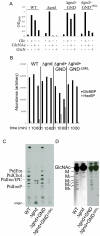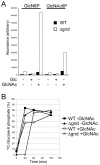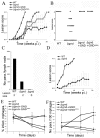Evidence that intracellular stages of Leishmania major utilize amino sugars as a major carbon source
- PMID: 21203480
- PMCID: PMC3009595
- DOI: 10.1371/journal.ppat.1001245
Evidence that intracellular stages of Leishmania major utilize amino sugars as a major carbon source
Abstract
Intracellular parasites, such as Leishmania spp, must acquire suitable carbon sources from the host cell in order to replicate. Here we present evidence that intracellular amastigote stages of Leishmania exploit amino sugars in the phagolysosome of mammalian macrophages as a source of carbon and energy. L. major parasites are capable of using N-acetylglucosamine and glucosamine as primarily carbon sources and contain key enzymes required for conversion of these sugars to fructose-6-phosphate. The last step in this pathway is catalyzed by glucosamine-6-phosphate deaminase (GND), which was targeted to glycosomes via a canonical C-terminal targeting signal when expressed as a GFP fusion protein. Mutant parasites lacking GND were unable to grow in medium containing amino sugars as sole carbohydrate source and rapidly lost viability, concomitant with the hyper-accumulation of hexosamine-phosphates. Expression of native GND, but not a cytosolic form of GND, in Δgnd parasites restored hexosamine-dependent growth, indicating that toxicity is due to depletion of glycosomal pools of ATP. Non-lethal increases in hexosamine phosphate levels in both Δgnd and wild type parasites was associated with a defect in promastigote metacyclogenesis, suggesting that hexosamine phosphate levels may influence parasite differentiation. Promastigote and amastigote stages of the Δgnd mutant were unable to replicate within macrophages and were either completely cleared or exhibited reduced lesion development in highly susceptible Balb/c mice. Our results suggest that hexosamines are a major class of sugars in the macrophage phagolysosome and that catabolism of scavenged amino sugars is required to sustain essential metabolic pathways and prevent hexosamine toxicity.
Conflict of interest statement
The authors have declared that no competing interests exist.
Figures








Similar articles
-
Role of hexosamine biosynthesis in Leishmania growth and virulence.Mol Microbiol. 2008 Aug;69(4):858-69. doi: 10.1111/j.1365-2958.2008.06314.x. Epub 2008 Jun 4. Mol Microbiol. 2008. PMID: 18532982
-
Intracellular Survival of Leishmania major Depends on Uptake and Degradation of Extracellular Matrix Glycosaminoglycans by Macrophages.PLoS Pathog. 2015 Sep 3;11(9):e1005136. doi: 10.1371/journal.ppat.1005136. eCollection 2015 Sep. PLoS Pathog. 2015. PMID: 26334531 Free PMC article.
-
Construction and characterization of a Saccharomyces cerevisiae strain able to grow on glucosamine as sole carbon and nitrogen source.Sci Rep. 2018 Nov 16;8(1):16949. doi: 10.1038/s41598-018-35045-8. Sci Rep. 2018. PMID: 30446667 Free PMC article.
-
Central carbon metabolism of Leishmania parasites.Parasitology. 2010 Aug;137(9):1303-13. doi: 10.1017/S0031182010000077. Epub 2010 Feb 17. Parasitology. 2010. PMID: 20158936 Review.
-
Intracellular growth and pathogenesis of Leishmania parasites.Essays Biochem. 2011;51:81-95. doi: 10.1042/bse0510081. Essays Biochem. 2011. PMID: 22023443 Review.
Cited by
-
Immunometabolism in Arthropod Vectors: Redefining Interspecies Relationships.Trends Parasitol. 2020 Oct;36(10):807-815. doi: 10.1016/j.pt.2020.07.010. Epub 2020 Aug 18. Trends Parasitol. 2020. PMID: 32819827 Free PMC article. Review.
-
Orchestration of the mammalian host cell glucose transporter proteins-1 and 3 by Chlamydia contributes to intracellular growth and infectivity.Pathog Dis. 2017 Nov 30;75(8):ftx108. doi: 10.1093/femspd/ftx108. Pathog Dis. 2017. PMID: 29040458 Free PMC article.
-
Isotopomer profiling of Leishmania mexicana promastigotes reveals important roles for succinate fermentation and aspartate uptake in tricarboxylic acid cycle (TCA) anaplerosis, glutamate synthesis, and growth.J Biol Chem. 2011 Aug 5;286(31):27706-17. doi: 10.1074/jbc.M110.213553. Epub 2011 Jun 2. J Biol Chem. 2011. PMID: 21636575 Free PMC article.
-
Sugar activation and glycosylation in Plasmodium.Malar J. 2015 Oct 31;14:427. doi: 10.1186/s12936-015-0949-z. Malar J. 2015. PMID: 26520586 Free PMC article. Review.
-
Role of cytosolic glyceraldehyde-3-phosphate dehydrogenase in visceral organ infection by Leishmania donovani.Eukaryot Cell. 2013 Jan;12(1):70-7. doi: 10.1128/EC.00263-12. Epub 2012 Nov 2. Eukaryot Cell. 2013. PMID: 23125352 Free PMC article.
References
-
- Swanson MS, Fernandez-Moreira E. A microbial strategy to multiply in macrophages: the pregnant pause. Traffic. 2002;3:170–177. - PubMed
-
- Schaible UE, Kaufmann SH. A nutritive view on the host-pathogen interplay. Trends Microbiol. 2005;13:373–380. - PubMed
-
- Appelberg R. Macrophage nutriprive antimicrobial mechanisms. J Leukoc Biol. 2006;79:1117–1128. - PubMed
-
- Naderer T, McConville MJ. The Leishmania-macrophage interaction: a metabolic perspective. Cell Microbiol. 2008;10:301–308. - PubMed
Publication types
MeSH terms
Substances
LinkOut - more resources
Full Text Sources
Other Literature Sources
Miscellaneous

